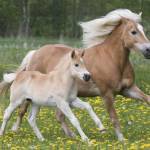The Mare’s Ageing Reproductive System

Mare, mare, quite contrary, how do your follicles grow?
Perhaps more importantly, how does the growth of follicles—the small sac on the ovary from which an egg is released—change with each passing year of a mare’s reproductive career? This and other questions related to the ageing equine reproductive tract were recently asked by a group of specialists*. Their goal was to better understand how age affects the fertility of broodmares.
“Aside from embryo transfer, highly valuable mares can only produce one foal each year. Having an improved understanding of how ageing impacts the reproductive system will permit owners to continue breeding their mares longer,” explained Catherine Whitehouse, M.S., who works for Kentucky Equine Research (KER).
Like other organ systems, such as the gastrointestinal and musculoskeletal systems, age negatively affects certain features and functions of the reproductive system. For example, in the aforementioned study, the research team relayed the following:
- Reproductive ageing in mares is associated with decreased fertility;
- Causes of age-related decreases in fertility include delayed uterine clearance, reduced oocyte (egg) quality, and a higher rate of early embryonic death;
- Ageing mares can begin to have longer intervals between estrous cycles. In some cases, this could be due to abnormal ovulation during the diestrous phase of the estrous cycle; and
- The number of antral or “resting” follicles, an indicator of follicular reserve, decreases as mares age. Once the supply of resting follicles depletes, ovarian failure ensues.
“The authors also noted that reproductive ageing doesn’t necessarily correlate directly with chronological age. Ensuring the overall health and well-being of your broodmare will help support the function of the reproductive system, prolonging its longevity,” Whitehouse said.
In addition to providing routine preventive healthcare and ensuring the maintenance of an appropriate body condition score, be sure to explore the benefits of omega-3 fatty acids for both the mare and her foal.
“KER offers EO-3, a potent and palatable marine-derived oil rich in the omega-3 fatty acids EPA and DHA,” said Whitehouse.
*Claes, A., B.A. Ball, K.E. Scoggin, et al. 2017. The influence of age, antral follicle count and diestrous ovulations on estrous cycle characteristics of mares. Theriogenology. 97:34-40.








